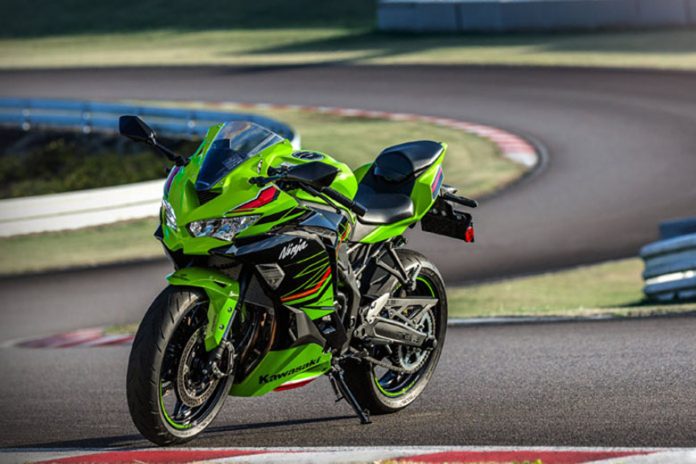The 2023 Kawasaki Ninja ZX-4RR Sports Motorcycle, with its sleek Ninja design, outperforms its predecessor thanks to an all-new chassis and engine that are significantly lighter and more powerful.
However, there’s more to this Ninja model than just stellar performance, just like the Ninja 300 that came before it. The Ninja 400 is aesthetically pleasing, pleasant, and easy to ride thanks to its powerful engine, light and predictable handling, and sporty, comfortable riding position.
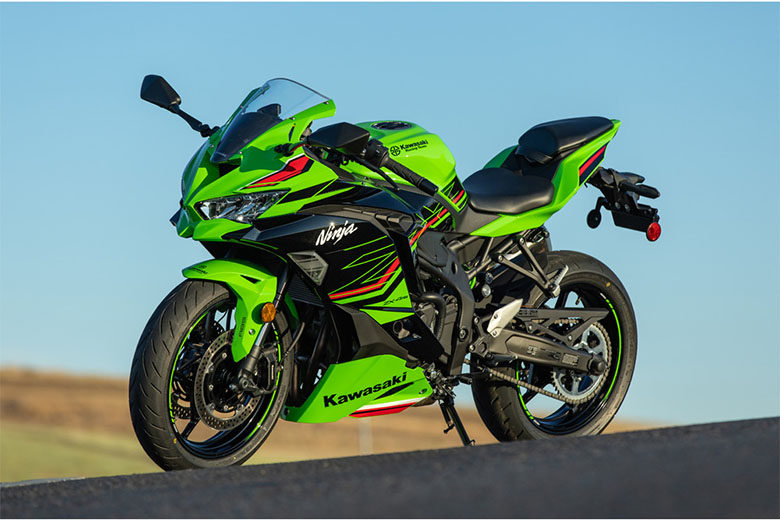
2023 Kawasaki Ninja ZX-4RR Sports Motorcycle – Features and Specs
Engine
The 2023 Kawasaki Ninja ZX-4RR Sports Motorcycle’s all-new 399cc liquid-cooled, 4-stroke, inline four-cylinder engine delivers thrilling performance and power that’s fun to ride. The all-new engine in the Ninja ZX-4RR was developed using inputs from other Kawasaki Ninja ZX supersport vehicles.
Also Read: 2023 Kawasaki Ninja ZX-4R Sports Motorcycle Review
It has a direct throttle response and is quick to rev, offering strong low-to-mid-range torque for city riding and high-rpm power for track days. Kawasaki’s inline four-cylinder engine’s distinctive intake and exhaust roars compliment the rider’s exhilarating acceleration experience as they roll on the throttle.
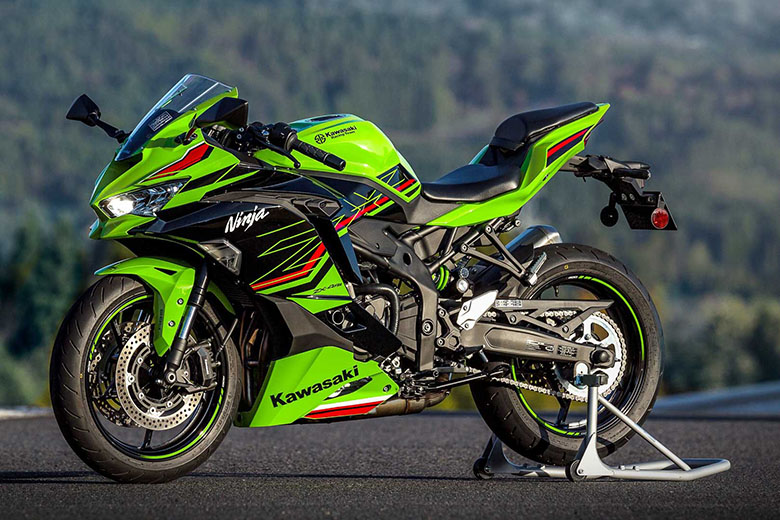
With a size and stroke of 57.0 x 39.16 mm, this liquid-cooled, DOHC, 16-valve, 399cc inline four-cylinder engine produces much torque. Remarkable top-end power is the result of the bore and stroke. Using the latest electronics from Kawasaki, a high-spec ECU like this is used on the Kawasaki Z H2.
Electronic throttle valves with 34mm throttle bodies allow the ECU to control the fuel and air delivered to the engine, resulting in smooth and organic engine response. They also make it easy to use Kawasaki’s electronic rider support features, including the dual-directional Kawasaki Quick Shifter that allows riders to feel “at one” with the motorcycle, with selectable power levels and traction control—integrated riding modes.
Fine sand is used in the sand-casting process to create a smooth interior finish for the intake ports. To give the intake air a more straight path as it enters the combustion chamber, the intake port exit, like the Ninja ZX-10R, is cut twice: once at an angle and once along the valve seats.
Also Read: 2023 Kawasaki Z125 Pro Street Sports Motorcycle Review
The engine performs better due to the broader and straighter intake air route, which encourages smoother flow and a greater volume of the fuel-air mixture. The lightweight forged camshaft is attributed to high-revving and high-rpm performance.
A large amount of air flows through the 19 mm exhaust valves, complementing the large 22.1 mm intake valves, for excellent high-rpm performance. Triple-rate valve springs adjust the valves to improve the Ninja ZX-4RR’s high-rpm performance. A narrow valve angle enhances combustion efficiency and results in a compact engine design. Only Kawasaki’s high-performance premium models use this production technology, which involves precision milling the combustion chambers to extremely tight tolerances.
Also Read: 2023 Vulcan 1700 Voyager Kawasaki Cruiser Review
Thanks to lightweight cast aluminum pistons, the relative weight reduction makes the quick climbing rpm possible. The molybdenum coating on the piston skirts makes them more durable. The 2023 Kawasaki Ninja ZX-4RR Sports Motorcycle’s 12.3:1 compression ratio results from a deliberate piston crown design, allowing for moderate fuel consumption while delivering powerful performance.
The piston’s short stroke increases performance at high rpm, but its wide bore makes it easier to use larger intake and exhaust valves to improve airflow. Using aluminum die-cast cylinders with an open-deck design achieves excellent heat dissipation and low engine weight.
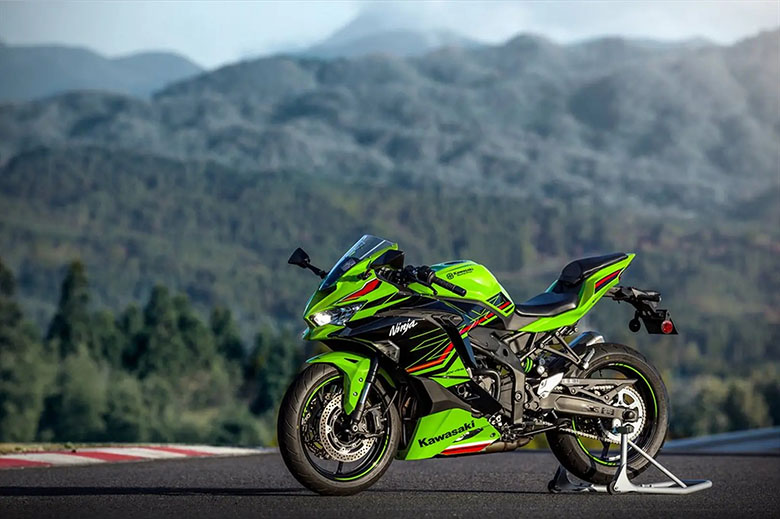
Kawasaki experts specifically chose the connecting rod ratio to minimize mechanical loss and vibration, and the connecting rods were given a unique carburizing process to increase strength and save weight. The crankshaft’s light flywheel mass attained a low moment of inertia, which helped produce a quick-revving engine and direct throttle response. Even while riding a sport or track, a deep oil pan keeps the oil pump intake completely submerged, preventing air from being ingested during severe acceleration and deceleration.
Chassis
While cruising around town, the 2023 Kawasaki Ninja ZX-4RR Sports Motorcycle is maneuverable. Yet, on the racetrack or out on the backroads, its high-level supersport character comes to the fore. Using input from their FIM World Superbike Championship competition, Kawasaki Racing Team (KRT) engineers selected key chassis components with the highest stiffness balance. The trellis structure, made of high tensile steel, has a swing arm pivot section and a thickness of several pipe diameters. Kawasaki’s sophisticated dynamic stiffness analysis ensured the necessary balance of strength and chassis flex.
Also Read: 2023 Kawasaki Vulcan 900 Classic Cruiser Review
Kawasaki’s World Superbike 2023 Kawasaki Ninja ZX-4RR Sports Motorcycle served as the model for several key chassis features, including caster angle, engine axis positions, swingarm pivot position, and center of gravity, which made it the World Superbike in the 400cc class. It also helped introduce chassis design.
The long-style swingarm is made of high-tensile steel, which adjusts the bike’s front-to-rear weight distribution for the ideal combination of agile handling and stable chassis behavior. The right side of the swingarm’s arch design adds to the Ninja ZX-4RR’s sleek, aggressive look while providing the necessary stiffness and flexibility to allow the silencer to be mounted as centrally as possible.
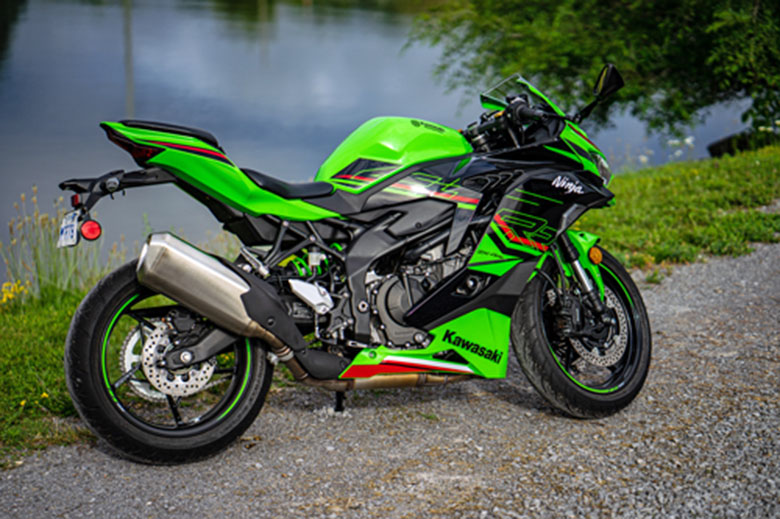
Styling
The most powerful engine in the 400cc class, the 2023 Kawasaki Ninja ZX-4RR Sports Motorcycle benefits from an aggressive Ninja style designed to give it a combative look while containing its power and explosive action. The ram air inlet, a distinguishing feature of the Ninja ZX models that sets the machine apart from its competitors, is prominently located in the center of the upper cowl.
It bears the “Ram Air” motif, a constant reminder of the bike’s superior performance. A fierce chin spoiler lends credence to the ninja family’s powerful image. With its small fuel tank surrounding the inline-four engine and its simple, form-fitting bodywork, the 2023 Kawasaki Ninja ZX-4RR Sports Motorcycle exudes a sleek, sophisticated appearance.
Sharp diagonal lines enhance the lightweight image that captures the bike’s agile supersport performance. In addition to adding aggressive lines for a fashionable appearance, side air ducts in the fairings combine form and function by drawing cool air into the engine. The new rear flap can be easily removed for race days, and the compact, race-style tail cowl gives a lightweight impression with its high slant.
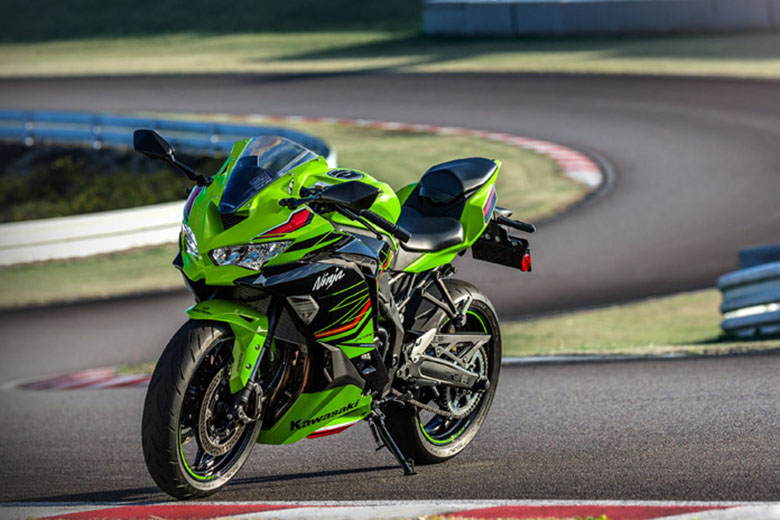
The 2023 Kawasaki Ninja ZX-4RR Sports Motorcycle has a brilliant and striking appearance thanks to its twin LED headlights. Its fairing is integrated with the LED front turn signals. The Ninja ZX-10R inspired the LED taillight, giving the motorcycle’s rear a classy look. The complete LED package includes LED turn signals and license plate lights at the rear.
Twin LED Headlamps
Slim LED headlamps (with low and high beams each and LED position lighting) not only give the Ninja 400 a more angular look but also significantly increase its brightness.
Powerful, Rider-Friendly Parallel Twin
The Ninja 400’s 399 cm3 engine offers a blend of controllability and performance. Compared to its predecessor, the engine delivers better performance and a satisfying sense of power at all rpm. An engine with a smooth and predictable response is easy to manage. Due to its efficient construction, the lightweight, compact engine is comparable in size to 250cc engines.
High-Grade Cockpit
The Ninja 400 features a large analog tachometer, a multi-function LCD screen, and a modern cockpit with warning LEDs on one side and gear position indicators on the other.
Most giant Brake Discs in Class
With a semi-floating front disc that provides reliable stopping power, the Ninja 400 features the same æ310 mm disc size as the 2023 Kawasaki Ninja ZX-4RR Sports Motorcycle. Brake contact is influenced by carefully selected brake line dimensions and materials. A stiffer new front brake master cylinder helps prevent inefficient (waste) strokes, aiding control, and featuring the latest and lightest ABS unit from Nissin on the market.
Relaxed, Sporty Riding Position
A comfortable rider triangle supports many rider sizes and riding conditions. The high handle position and slightly forward footpeg position keep the rider comfortable yet controllable, unlike other models whose relatively radical riding stance sacrifices comfort.
Easy Reach to the Ground
Despite the 785 mm seat height, riders are not hindered by the narrow shape of the seat and the rear of the engine.
Sharp Ninja Styling
Regardless of being homeless, Ninja models are always known for turning heads, and inspired by the mighty Ninja H2, the new Ninja 400 features revolutionary new Ninja styling. The attention-grabbing massive bodywork creates the illusion of a more giant machine. Premium design and excellent fit and finish, on par with bikes in the high-displacement class, reinforce this impression.
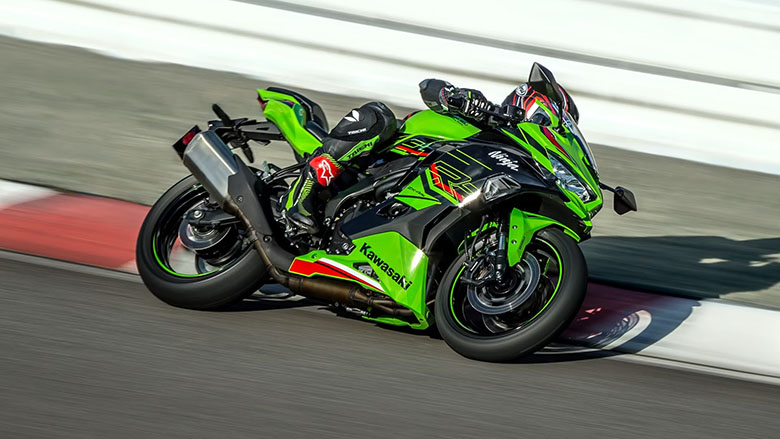
Lightweight Trellis Frame
The 2023 Kawasaki Ninja ZX-4RR Sports Motorcycle has a trellis structure reminiscent of the Ninja H2‘s design. Kawasaki’s latest dynamic stiffness analysis was employed to guarantee ideal stiffness with minimal weight. The engine acts as a stressed component and is rigidly mounted. The bike’s low curb mass is largely due to the frame design.
2023 Kawasaki Ninja ZX-4RR Sports Motorcycle – Technical Specifications
Engine
| Engine type | Liquid-cooled, 4-stroke Parallel Twin |
| Displacement | 399 cm³ |
| Bore x stroke | 70 x 51.8 mm |
| Compression ratio | 11.5:1 |
| Valve system | DOHC, eight valves |
| Fuel system | Fuel injection: Ø 32 mm x 2 |
| Starting System | Electric |
| Lubrication | Forced lubrication, wet sump |
Performance & Transmission
| Maximum power | 33.4 kW {45 PS} / 10,000 rpm |
| CO2 emission | 91 g/km |
| Maximum torque | 37 N•m {3.8 kgf•m} / 8,000 rpm |
| Transmission | 6-speed |
| Final drive | Sealed chain |
| Primary Reduction Ratio | 2.219 (71/32) |
| Gear Ratios 1st | 2.929 (41/14) |
| Gear Ratios 2nd | 2.056 (37/18) |
| Gear Ratios 3rd | 1.619 (34/21) |
| Gear Ratios 4th | 1.333 (32/24) |
| Gear Ratios 5th | 1.154 (30/26) |
| Gear Ratios 6th | 1.037 (28/27) |
| Final reduction ratio | 2.929 (41/14) |
| Clutch | Wet multi-disc, manual |
Brakes & Suspension
| Brakes, front | Single semi-floating 310 mm petal discs. Caliper: Single balanced actuation dual-piston |
| Brakes, rear | Single 220 mm petal disc. Caliper: Dual-piston |
| Suspension, front | 41mm telescopic fork |
| Suspension, rear | Bottom-Link Uni-Trak, gas-charged shock with adjustable preload |
Frame & Dimensions
| Frame type | Trellis, high-tensile steel |
| Trail | 92 mm |
| Wheel travel front | 120 mm |
| Wheel travel rear | 130 mm |
| Tyre, front | 110/70R17 M/C 54H |
| Tyre, rear | 150/60R17 M/C 66H |
| Tyre, rear | 150/60R17 M/C 66H |
| L x W x H | 1,990 x 710 x 1,120 mm |
| Wheelbase | 1,370 mm |
| Ground clearance | 140 mm |
| Fuel capacity | 14 litres |
| Seat height | 785 mm |
| Curb mass | 168 kg |

